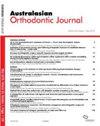A comparison of bond strength and adhesive remnant index of 3D-printed and metal orthodontic brackets attached using different adhesives
IF 0.9
4区 医学
Q4 DENTISTRY, ORAL SURGERY & MEDICINE
引用次数: 0
Abstract
Abstract Introduction The aim of this in vitro study was to evaluate the shear bond strength (SBS) and adhesive remnant index (ARI) scores of two different adhesive applications of aesthetic brackets produced from permanent crown material using 3D-printing technology. Methods Sixty maxillary premolar teeth extracted for orthodontic reasons were divided into two main groups according to the type of bracket (metal brackets n=30, 3D-printed brackets n=30) and further divided into two subgroups according to the type of adhesive (flowable composite, Tokuyama SuperLow; non-flowable composite; 3M Transbond XT). SBS and ARI score evaluations were conducted in the experimental and control subgroups (n=15). Statistical analysis was performed by a one-way analysis of variance, a post-hoc test, and Fisher’s exact test. Statistical significance was accepted as P < 0.05. Results The bond strength of the specimens was significantly affected by the type of composite and bracket type (P < 0.001). However, the SBS values were within or above the desired range for orthodontic treatment in all groups. The highest SBS value was obtained in the Metal Bracket-Transbond XT group (15.03 ± 6.66), while the lowest SBS value was observed in the 3D-Printed Bracket-Transbond XT group (7.91 ± 3.07). It was noted that of all materials evaluated, the most common non-enamel-damaging adhesive–cohesive fractures were in 3D-Printed Bracket Tokuyama SuperLow group (n=13). Conclusions It is recommended that 3D-printed orthodontic brackets have sufficient and acceptable SBS levels for clinical applications and bonding using non-flowable adhesives to produce high SBS values and using flowable adhesives generating high ARI scores.3D打印托槽与金属托槽不同粘接剂粘接强度及残留指数的比较
摘要:本体外研究的目的是评估两种不同粘合剂应用的剪切粘接强度(SBS)和粘接残余指数(ARI)分数,这些粘接应用是用3d打印技术由永久冠材料制成的美学支架。方法将60颗因正畸原因拔牙的上颌前磨牙按托槽类型分为两大类(金属托槽n=30, 3d打印托槽n=30),按粘接剂类型分为两大类(流动复合、Tokuyama SuperLow;non-flowable复合;3M Transbond XT)。对实验组和对照组(n=15)进行SBS和ARI评分评估。统计分析采用单因素方差分析、事后检验和Fisher精确检验。以P < 0.05为差异有统计学意义。结果复合材料类型和托槽类型对试件粘结强度有显著影响(P < 0.001)。然而,SBS值在所有组正畸治疗的期望范围内或以上。其中,金属支架-跨键XT组SBS值最高(15.03±6.66),3d打印支架-跨键XT组SBS值最低(7.91±3.07)。值得注意的是,在所有评估的材料中,最常见的非牙釉质损伤粘连性骨折是3d打印托架Tokuyama超低组(n=13)。结论建议3d打印正畸托槽具有足够的、可接受的SBS水平,可用于临床应用,使用非流动粘接剂粘接可产生高SBS值,使用流动粘接剂粘接可产生高ARI评分。
本文章由计算机程序翻译,如有差异,请以英文原文为准。
求助全文
约1分钟内获得全文
求助全文
来源期刊

Australasian Orthodontic Journal
Dentistry-Orthodontics
CiteScore
0.80
自引率
25.00%
发文量
24
期刊介绍:
The Australasian Orthodontic Journal (AOJ) is the official scientific publication of the Australian Society of Orthodontists.
Previously titled the Australian Orthodontic Journal, the name of the publication was changed in 2017 to provide the region with additional representation because of a substantial increase in the number of submitted overseas'' manuscripts. The volume and issue numbers continue in sequence and only the ISSN numbers have been updated.
The AOJ publishes original research papers, clinical reports, book reviews, abstracts from other journals, and other material which is of interest to orthodontists and is in the interest of their continuing education. It is published twice a year in November and May.
The AOJ is indexed and abstracted by Science Citation Index Expanded (SciSearch) and Journal Citation Reports/Science Edition.
 求助内容:
求助内容: 应助结果提醒方式:
应助结果提醒方式:


